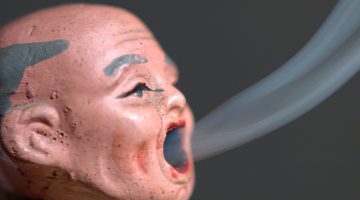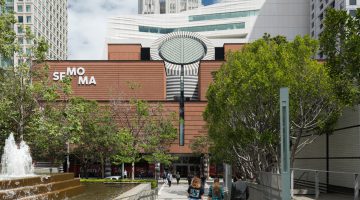
Michael Light, Black Mountain 07 Unbuilt “Ascaya” Development Looking Southeast; $250 Million In Mountaintop Removal and Terracing, Henderson, NV, 2012. Archival pigment print mounted on aluminum, 40 x 50 inches.
Map making and map collecting represent self-control in an environment—you know the lay of the land. In Hosfelt Gallery’s “Private Frontiers: Chris Ballantyne & Michael Light,” aerial map maker and archivist Michael Light leads the charge: his monumental color prints of Nevada’s luxury neighborhoods on mountain tops set the tone of America’s financial over-extension, and subsequent abandonment after the Great Recession. Chris Ballantyne’s paintings on paper, canvas, panel, and the gallery wall explore suburban America with the same gravity, but, because they are small, end up playing the part of confederate to Light’s photographs.

Michael Light, Golf Course:“Wolf Creek Golf Resort” Looking Southeast, Mesquite, Nevada, 2010. Pigment print mounted on aluminum, 59 x 74 inches. Edition of 2.
In an interview with Robert Hirsch about his book of photographs of nuclear detonation sites “100 SUNS,” Michael Light cites Gerhard Richter’s “Atlas” as an inspiration. “Atlas” is a work begun by Richter in 1962, a collection of thousands of newspaper clippings, photographs, and sketches dating back to 1945. It is a self-edited encyclopedia of mainly German history, and provides the source material for Richter’s work; it’s a map of perception of world events without artifice, which have been insufficiently addressed by a culture or its artists (Germans are good at ignoring Hitler’s Germany and East Berlin), and are ultimately perceived in the isolation of an individual’s unique reality. It is an opportunity to recollect. Light is creating his own encyclopedia of Earth and its moon’s terrains. His photos are a memory device of our landscapes, the ways humans have changed them (sometimes horribly by bombs or leveling), and the collective psychological state that leads to bombings or overspending. Americans have done a good job ignoring the events that led to our most recent financial collapse.
Voyeuristically examining Light’s high-definition photographs for construction tools and pool vacuums takes time. Chris Ballantyne’s paintings are similarly slow paced for the viewer: there are paths to follow, and gradients in paint thickness to examine. He paints scenes of human development in distinct landscapes (cliffs, deserts) that remain geographically vague. In an interview with Ben Portis, Ballantyne said he uses Google image search for subject matter, which accounts for the painting’s emotional distance. Pipelines and huge empty parking lots are more easily reflected on when presented with tempered emotion, and painting from online photos creates that kind of separation. People are most receptive to calm persuasion.
Curation creates a beat and some days my body and mind can’t match its pacing. Both Chris Ballantyne and Michael Light’s work deserve patience and attention, but that can be difficult to sustain for three large galleries and dozens of works. The monumental size of Light’s photographs called me away from Ballantyne’s 12 x 16 inch paintings, and even Ballantyne’s image extending murals on the gallery walls couldn’t stop it. I think I’ll go back a second time.

Michael Light, Lake Las Vegas 2010-2012 14. Future Homesites of “The Falls” at Lake Las Vegas, Henderson, Nevada, 2011. Pigment print mounted on aluminum, 40 x 50 inches. Edition of 5.
“Private Frontiers: Chris Ballantyne & Michael Light” is on view at Hosfelt Gallery through January 26, 2013.
-Kendall George
Citations Hirsch, Robert. “100 Suns and the Nuclear Sublime: An Interview with Michael Light,” Afterimage, v. 33 no1 (July/August 2005). 2005. Web 21 December 2012. http://www.michaellight.net/n_interview2005.html
Portis, Ben. “Wallworks: Contemporary Artists and Place” Catalogue. Art Gallery of Ontario, 2007. Web 21 December 2012. http://www.chrisballantyne.com/wallworks.pdf.
All images via Hosfelt Gallery.




